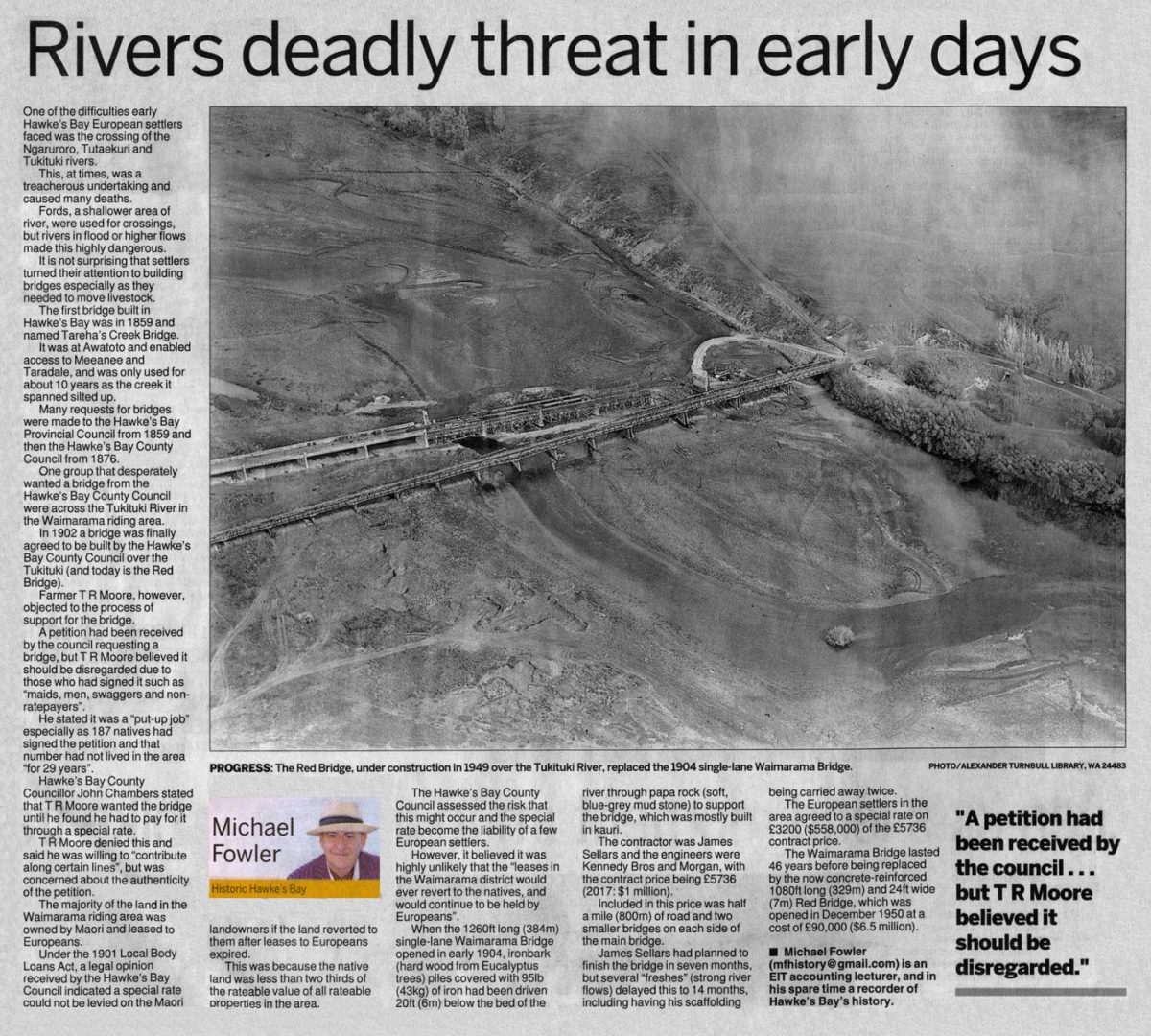Rivers deadly threat in early days
Michael Fowler
Historic Hawke’s Bay
One of the difficulties early Hawke’s Bay European settlers faced was the crossing of the Ngaruroro, Tutaekuri and Tukituki rivers.
This, at times, was a treacherous undertaking and caused many deaths.
Fords, a shallow area of river, were used for crossings but rivers in flood or higher flows made this highly dangerous.
It is not surprising that settlers turned their attention to building bridges especially as they needed to move livestock.
The first bridge built in Hawke’s Bay was in 1859 and named Tareha’s Creek Bridge.
It was at Awatoto and enabled access to Meeanee and Taradale, and was only used for about 10 years as the creek it spanned silted up.
Many requests for bridges were made to the Hawke’s Bay Provincial Council from 1859 and then the Hawke’s Bay County Council from 1876.
One group that desperately want a bridge from the Hawke’s Bay County Council were across the Tukituki River in the Waimarama riding area.
In 1902 a bridge was finally built by the Hawke’s Bay County Council over the Tukituki (and today is the Red Bridge).
Farmer T R Moore, however, objected to the process of support for the bridge.
A petition had been received by the council requesting a bridge, but T R Moore, believed it should be disregarded due to those who had signed it such as “maids, men, swaggers and non-ratepayers”.
He stated it was a “put-up job” especially as 187 natives had signed the petition and that number had not lived in the area “for 29 years”.
Hawke’s Bay County Councillor John Chambers stated that T R Moore wanted the bridge until he found he had to pay for it through a special rate.
T R Moore denied this and said he was willing to “contribute along certain lines”, but was concerned about the authenticity of the petition.
The majority of the land in the Waimarama riding area was owned by Māori and leased to Europeans.
Under the 1901 Local Body Loans Act, a legal opinion received by the Hawke’s Bay Council indicated a special rate could not be levied on the Maori landowners, if the land reverted to them after leases to Europeans expired.
This was because the native land was less than two thirds of the rateable properties in the area.
The Hawke’s Bay County Council assessed the risk that this might occur and the special rate become the liability of a few European settlers.
However, it believed it was highly unlikely that the “leases in the Waimarama district would ever revert to the natives, and would continue to be held by Europeans”.
When the 1260ft long (384m) single-lane Waimarama Bridge opened in early 1904, ironbark (hard wood from Eucalyptus trees) piles covered with 95lb (43kg) of iron had been driven 20ft (6m) below the bed of the river through papa rock (soft blue-grey mud stone) to support the bridge, which was mostly built in kauri.
The contractor was James Sellars and the engineers were Kennedy Bros and Morgan, with the contract price being £5736 (2017: $1 million).
Included in this price was half a mile (800m) of road and two smaller bridges on each side of the main bridge.
James Sellars had planned to finish the bridge in seven months, but several “freshes” (strong river flows) delayed this to 14 months, including having his scaffolding being carried away twice.
The European settlers in the area agreed to a special rate on £3200 ($558,000) of the £5736 contract price.
The Waimarama Bridge lasted 46 years before being replaced by the now concrete-reinforced 1080ft long (329m) and 24ft wide (7m) Red Bridge, which was opened in December 1950 at a cost of £90,000 ($6.5 million).
Michael Fowler ([email protected]) is an EIT accounting lecturer, and in his spare time a recorder of Hawke’s Bay history.
“A petition had been received by the council… but T R Moore believed it should be disregarded.”
Photo caption – PROGRESS: The Red Bridge, under construction in 1949 over the Tukituki River, replaced the 1904 single-lane Waimarama Bridge. PHOTO/ ALEXANDER TURNBULL LIBRARY, WA24483












Do you know something about this record?
Please note we cannot verify the accuracy of any information posted by the community.